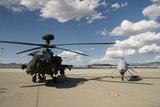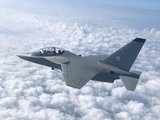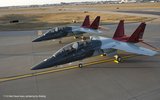Naval aviation commanders spotlight future training strategy at I/ITSEC 2022
Project Avenger focuses on reducing time spent on the T-6 by using low-cost VR solutions. (Photo: author)
One of the most eagerly awaited sessions of I/ITSEC’s programme was the US Naval Aviation Flag Panel. Drawing together 13 stars shared between six participants, the panel discussed topics ranging from fleet readiness to adoption of new technologies to accelerate training, exploitation of data analytics and the Integrated Training Facility at NAS Fallon.
VAdm Kenneth Whitesell, Commander Naval Air Forces and Commander Naval Air Force US Pacific Fleet highlighted his priorities, and these included ‘winning the great power competition... and to revolutionise training.’ Describing the carrier air wing of the future, Whitesell underscored the importance of training, especially the US Navy’s Avenger, Hellcat and Corsair projects.
Discussing Project Avenger in more depth, RAdm Richard Brophy, Chief of Naval Air Training (CNATRA), told delegates that his training pipeline ‘was like a giant conveyor belt, but we need more aviators to the fleet faster so the way we changed that was to use technology to accelerate the throughput'. Brophy said that some students ‘have now gone solo after just four flights’.
Related Articles
I/ITSEC 2022: ASTi integrates simulated environment in Lockheed Martin demo centre
Fireside Chat forum speakers stress need for training acceleration at I/ITSEC 2022

From left to right: RAdms, Hash, Hornbuckle, McCoy, Loiselle and VAdm Whitesell. (Photo: author)
Brophy also made an interesting comment on how Avenger is able to harvest data from each student that can be used to modify delivery of future training. Surprisingly to some, Brophy called on industry to provide ‘training solutions, not pie in the sky but something I can use now'.
Bearing in mind Avenger has been operating for over two years, it might be thought that potential suppliers would have been recognised and solutions would have already been in place.
One other area of training investment currently managed by the USN is through its Naval Aviation Warfighting Development Center. Its Commandant RAdm Max McCoy discussed the modernisation of 40 F-16 aircraft to replace 'classic' F/A-18 Hornets in the adversary role at NAS Fallon.
McCoy has his work cut out with Fallon’s Integrated Training Facility (ITF) expected to achieve initial operating capability in March and the fact that ‘we’re training nine air wings over the next 12 months’.
Discussing the ITF, McCoy said the new facility will provide ‘an LVC training capability that is critical to create capacity and generate capability'. Part of the process again focuses on the collection of data and its analysis.
‘One of the issues in collecting data from an operational training environment is the security of those data,’ he said. Challenges aside, McCoy made the point that data ‘not only needs to look forward but also to help us realise what we don’t need to do any more’.
Data not only needs to look forward but also to help us realise what we don’t need to do any more.'— RAdm Max McCoy, Commandant, Naval Aviation Warfighting Development Center
McCoy made the point, one that has been made many times over the years, that the USN needs to move more training ‘down to the left’ to allow pilots more operationally focused learning when they get to their fleet replacement squadrons and then ITF.
As I/ITSEC Senior Leader Panel member Caroline Baxter flagged the previous day, the US services need to start working together and this is certainly the case with the naval aviation community who will be networking ITF with the air force’s Joint Simulation Environment (JSE).
Another topic raised many times in the past but which is still a major issue was highlighted by RAdm Andrew Loiselle, Director, Air Warfare Division, Office of the Chief of Naval Operations. He told delegates that with sixth-generation aircraft on the horizon, ‘we must ensure that simulation is integrated from day one and not applied later as a band aid'.
One of the questions from the floor concerned training for the MQ-25 Stingray. Whitesell told the audience that the first ten students had graduated in March, and this cohort is now being used to help develop the training syllabus for the navy and US Marine Corps.
Another question that drew discussion concerned the live-virtual balance. Whitesell said that the USN has defined the balance although ‘I will not tell you now, but it does preserve flight time. There’s got to be a fear factor.’ Draw from that what you will.
It should not be forgotten though that the navy, along with the rest of government, is suffering from a budget blockage in terms of Continuing Resolutions that is currently stalling many procurements. In the words of Whitesell: 'It is incomprehensible that Americans are letting Americans run to a cliff like this. Incomprehensible.'
Shephard's I/ITSEC 2022 coverage is sponsored by:

More from I/ITSEC 2022 Show Portal
-
![I/ITSEC 2022: HII enhances human-machine teaming training for US Army]()
I/ITSEC 2022: HII enhances human-machine teaming training for US Army
HII’s crewed-uncrewed teaming training system has been tested with the US Army’s Apache, but it can operate with any autonomous system with the right equipment to receive data.
-
![All the news from I/ITSEC and talking seabed warfare]()
All the news from I/ITSEC and talking seabed warfare
The Shephard Media news team looks at all the developments in the military training and simulation world, and discovers the trends and challenges in seabed warfare.
-
![Leonardo explores 6th-generation combat aircraft simulation at I/ITSEC 2022]()
Leonardo explores 6th-generation combat aircraft simulation at I/ITSEC 2022
Leonardo is developing the Smart Chair system in its Battle Lab that allows for advanced pilot training for multi-domain scenarios and can potentially 'replicate a sixth-generation fighter jet cockpit'.
-
![I/ITSEC 2022: Red Hawk jet trainer to be digital platform from day one]()
I/ITSEC 2022: Red Hawk jet trainer to be digital platform from day one
Boeing's T-7A Red Hawk simulator and maintenance training system will allow pilots and ground crew to train in novel ways as soon as the platforms are delivered.
-
![I/ITSEC 2022: Saab stays focused and committed to multi-site training delivery]()
I/ITSEC 2022: Saab stays focused and committed to multi-site training delivery
Saab has increased training activities across core markets, opened combined training centres and is set to grow its business further.
-
![I/ITSEC 2022: CAE to create ‘data ecosystem’ in synthetic environment and rethink approach to innovation]()
I/ITSEC 2022: CAE to create ‘data ecosystem’ in synthetic environment and rethink approach to innovation
CAE believes the future of training technologies will be fundamentally driven by bringing different industries together and no single company can exist in a vacuum - an approach that defence should adopt too.

























